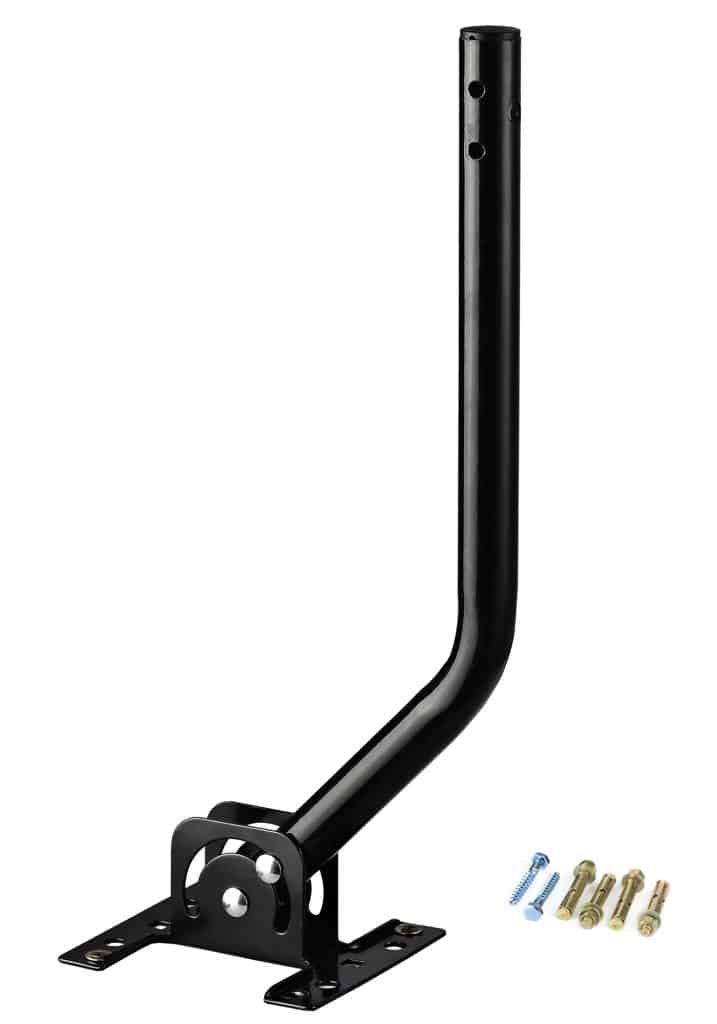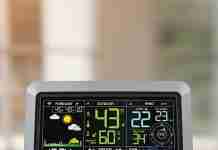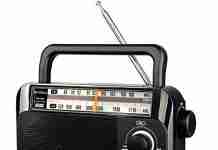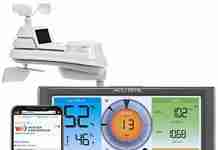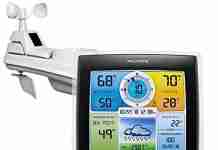When it comes to setting up a weather station, choosing the right pole is crucial for accurate data collection. But with so many options available, it can be a daunting task to determine the best fit. In this article, we will guide you through the various factors to consider when selecting a weather station pole, such as height, material, and stability. By the end, you’ll have all the information you need to make an informed decision and ensure your weather station stands tall in any weather condition.
Review contents
Factors to Consider
When choosing a pole for a weather station, there are several important factors to consider. These factors will ultimately determine the durability, height, and material of the pole, which are crucial for optimal performance and reliability of the weather station.
Durability
Durability is a key factor to consider when selecting a pole for a weather station. Since weather stations are often installed outdoors and exposed to various weather conditions, it is essential to choose a pole that can withstand the elements. Look for poles made from sturdy materials such as stainless steel or aluminum, which can resist corrosion and provide long-lasting durability.
Height
The height of the pole is another critical factor to consider. The height of the pole will depend on various factors, including the location of the weather station and the desired range of data collection. Ideally, the pole should be tall enough to ensure accurate and reliable weather measurements. However, it should also be within reach for easy maintenance and calibration. Consider the specific requirements of your weather station and choose a pole that meets those needs.
Material
The material of the pole is an important consideration as it directly impacts the durability and longevity of the weather station. Stainless steel and aluminum are popular choices due to their corrosion-resistant properties and strength. These materials can withstand harsh weather conditions without compromising the stability of the weather station. Additionally, they are lightweight, making installation and maintenance easier. When selecting a pole material, prioritize quality to ensure the longevity of your weather station.
Types of Poles
There are three main types of poles commonly used for weather stations: telescoping poles, fixed poles, and tripod poles. Each type has its own advantages and disadvantages, so it is important to understand their characteristics before making a decision.
Telescoping Poles
Telescoping poles, as the name suggests, can be extended or retracted to adjust the height of the weather station. This flexibility makes telescoping poles a popular choice for weather stations in areas with varying terrain or buildings of different heights. They allow for easy adjustments without the need for dismantling or reinstalling the entire pole. However, telescoping poles may not be as stable as fixed poles, especially when fully extended. It is important to carefully assess the environmental conditions and the weight of the weather instruments before choosing a telescoping pole.
Fixed Poles
Fixed poles offer a more stable and sturdy option for weather stations. These poles are permanently fixed in place and cannot be adjusted in terms of height. Fixed poles are ideal for installations in areas with a consistent terrain or where precision measurements are required. The lack of adjustability may pose a challenge if the weather station needs to be relocated or if buildings obstruct the desired line of sight for data collection. However, for many weather station applications, the stability and reliability of fixed poles make them the preferred choice.
Tripod Poles
Tripod poles are a unique type of pole that offers both stability and flexibility. They consist of three legs that can be easily adjusted for height and conveniently folded for portability. Tripod poles are particularly useful for temporary weather station setups or for researchers and weather enthusiasts who frequently move their stations to different locations. However, tripod poles may not offer the same level of stability as fixed or telescoping poles, especially in extreme weather conditions or areas prone to strong winds. Consider the specific needs and circumstances of your weather station before choosing a tripod pole.
This image is property of ambientweather.com.
Telescoping Poles
Telescoping poles offer several advantages and disadvantages that should be taken into account when selecting a pole for a weather station.
Advantages
One of the main advantages of telescoping poles is their adjustability. The ability to extend or retract the pole allows for easy customization of the height, ensuring optimal placement of the weather instruments. This adjustability is particularly beneficial in areas with varying terrain or buildings of different heights. Telescoping poles also offer the convenience of easy installation and maintenance, as they can be adjusted without the need for dismantling or reinstalling the entire pole. Additionally, telescoping poles are often lightweight, making them easier to transport and handle.
Disadvantages
While telescoping poles offer flexibility and convenience, they may not provide the same level of stability as fixed poles. When fully extended, telescoping poles may be more prone to swaying or vibrations, especially in areas with strong winds. This can potentially affect the accuracy and reliability of the weather measurements. It is important to carefully assess the environmental conditions and the weight of the weather instruments to ensure the telescoping pole can adequately support the equipment. Additionally, telescoping poles may require more frequent maintenance and adjustment to ensure the stability of the weather station.
Fixed Poles
Fixed poles offer stability and durability, making them a popular choice for weather station installations.
Advantages
One of the main advantages of fixed poles is their stability. Once installed, fixed poles provide a sturdy and secure platform for weather instruments, minimizing the risk of swaying or vibrations, which can affect the accuracy of the data collected. Fixed poles are also low-maintenance, as they do not require frequent adjustments or maintenance to ensure stability. This can be particularly beneficial for long-term weather station installations or in areas with consistent terrain or buildings. Additionally, fixed poles can often be customized to meet specific height requirements, ensuring the weather instruments are positioned at the optimal height for accurate data collection.
Disadvantages
The lack of adjustability is one of the main disadvantages of fixed poles. In situations where the weather station needs to be relocated or buildings obstruct the line of sight for data collection, fixed poles may not be the most suitable option. Relocating a fixed pole can be a complex and time-consuming process that requires disassembling and reinstalling the entire pole. Additionally, fixed poles may be heavier and more challenging to transport compared to other types of poles. The lack of adjustability can also pose a challenge if the weather station requires regular maintenance or calibration.
This image is property of Amazon.com.
Tripod Poles
Tripod poles offer a unique combination of stability and flexibility, making them a versatile choice for various weather station setups.
Advantages
One of the main advantages of tripod poles is their portability. The tripod design allows for easy folding and transportation, making them ideal for temporary weather station setups or for researchers and weather enthusiasts who frequently move their stations. Tripod poles also offer adjustability in terms of height, allowing for customization of the weather instruments’ positioning. This flexibility can be beneficial in areas with varying terrain or when precise data collection is required. Additionally, tripod poles are generally lightweight, making them easier to handle and install.
Disadvantages
While tripod poles offer portability and adjustability, they may not provide the same level of stability as fixed poles. The three legs of the tripod can be susceptible to swaying or vibrations, especially in areas with strong winds or when the weather instruments are heavy. This can potentially affect the accuracy and reliability of the data collected. Tripod poles may require additional precautions, such as using guy wires or securing the legs to the ground, to mitigate these stability concerns. It is important to assess the specific environmental conditions and weight requirements of the weather instruments before choosing a tripod pole.
Mounting Options
In addition to the type of pole, the choice of mounting options is another important consideration when installing a weather station.
Wall Mount
Wall mounts offer a convenient and space-saving option for weather station installations. They are typically fixed directly to a vertical surface, such as a building wall, using brackets or mounting plates. Wall mounts are ideal for locations where space is limited or when the weather station needs to be close to an existing structure, such as a building or a wall. However, it is important to ensure that the chosen wall and mounting hardware can adequately support the weight of the weather instruments and the pole itself. Additionally, the height and placement of the weather station may be limited by the available wall space.
Roof Mount
Roof mounts provide an alternative option for weather station installations, especially in areas where wall mounting is not feasible or desired. These mounts are typically fixed to the roof of a building, allowing for a higher elevation and better line of sight for data collection. Roof mounts can also help minimize interference from nearby structures, reducing the risk of inaccurate readings. However, it is important to consider the structural integrity of the roof and the safety precautions required for installation and maintenance. Rooftop installations may also pose challenges in terms of accessibility and exposure to extreme weather conditions.
Ground Mount
Ground mounts offer flexibility and accessibility in weather station installations. They are typically installed directly into the ground using a sturdy base or foundation. Ground mounts allow for greater customization of the weather station’s height and positioning, as they are not limited by existing structures. This option is particularly beneficial in open areas or when the weather station needs to be strategically located for accurate data collection. However, ground mounts may require additional considerations for stability, especially in areas with soft or uneven ground. It is important to ensure proper anchoring and stability measures to prevent the pole from shifting or leaning over time.
This image is property of www.georgelovesweather.com.
Installation Considerations
When choosing a pole for a weather station, several installation considerations need to be taken into account. These factors can ultimately determine the ease of installation, maintenance requirements, and budget of the weather station setup.
Ease of Installation
The ease of installation is an important consideration, especially for individuals without professional installation experience. Some poles may require specialized tools or equipment for installation, while others may come with detailed instructions and user-friendly features. Consider the complexity of the installation process and assess your own skill level and resources before choosing a pole for your weather station.
Maintenance Requirements
Maintenance requirements can vary depending on the type of pole and the environmental conditions of the installation site. Telescoping poles, for example, may require more frequent adjustments and inspections to ensure stability and proper functioning. On the other hand, fixed poles may require minimal maintenance once installed. Consider the specific maintenance requirements of the chosen pole and assess your ability or willingness to fulfill those requirements to ensure the longevity and reliability of your weather station.
Budget
Budget is an important consideration when selecting a pole for a weather station. The cost can vary significantly depending on factors such as the type of pole, material, and brand. It is important to establish a budget and prioritize features and specifications that align with your requirements. Consider the long-term investment and evaluate the quality and durability of the pole to ensure the best value for your money.
Popular Pole Brands
When it comes to pole options for weather stations, there are several reputable brands that offer reliable and high-quality products. Here are three popular pole brands to consider:
Brand 1
Brand 1 is known for its durable and robust poles specifically designed for weather station installations. Their poles are made from high-quality materials, such as stainless steel, that provide excellent durability and resistance to corrosion. The telescoping poles offered by Brand 1 are praised for their stability and easy adjustability. With a range of mounting options and customizable features, Brand 1 offers versatile solutions for various weather station setups.
Brand 2
Brand 2 is a trusted name in the industry, offering a wide range of poles suitable for different weather station applications. Their fixed poles are known for their stability and strength, providing a sturdy platform for weather instruments. Brand 2 also offers tripod poles that combine portability and stability, making them ideal for temporary or mobile weather station setups. With a focus on quality and reliability, Brand 2 poles are favored by professionals and weather enthusiasts alike.
Brand 3
Brand 3 has earned a reputation for its innovative and high-performance poles for weather stations. Their telescoping poles are praised for their advanced features and ease of use. Brand 3 offers telescoping poles with enhanced stability and precision, ensuring accurate and reliable data collection. With a commitment to quality and technological advancements, Brand 3 continues to be a popular choice among weather station users.
This image is property of www.georgelovesweather.com.
Conclusion
Choosing the best pole for a weather station involves considering several important factors such as durability, height, material, type of pole, mounting options, installation considerations, and budget. Each factor plays a crucial role in ensuring the optimal performance and reliability of the weather station. Whether you opt for a telescoping pole, fixed pole, or tripod pole, it is essential to select a pole that can withstand the environmental conditions and support the weight of the weather instruments. By considering these factors and choosing a reputable brand, you can confidently select the best pole for your weather station setup and enjoy accurate and reliable weather measurements.



